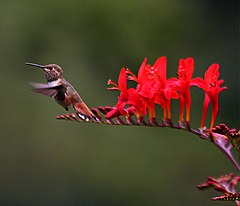Crocosmia
| LATINNAME {{{latin_name}}}
|
'
| ||||||||||||||||||||||||||||||||||||||||
|---|---|---|---|---|---|---|---|---|---|---|---|---|---|---|---|---|---|---|---|---|---|---|---|---|---|---|---|---|---|---|---|---|---|---|---|---|---|---|---|---|---|

|
|
| |||||||||||||||||||||||||||||||||||||||
| |||||||||||||||||||||||||||||||||||||||||
| Standard Cyclopedia of Horticulture |
|---|
|
Crocosmia (Greek, odor of saffron, which is perceivable when the dried flowers are placed in warm water). Iridaceae. Gladiolus-like garden plant. This genus has but one species, and is not clearly distinguished from the closely allied Tritonia, but it differs in the stamens being separated at equal distances instead of grouped at one side, the form of the limb, the tube not swollen at the top, and the fr. 3-seeded, sometimes 5-seeded, instead of many-seeded. The name of this genus is spelled Crocosma by Baker, but it was first spelled Crocosmia. The fls. with coppery tips shading into orange - yellow are very distinct and attractive. Pax, in Engler & Prantl, combines the genus with Tritonia. Crocosmia aurea is a showy bulbous autumn- blooming plant, which is hardy south of Washington, D. C., with slight protection, and in the North is treated like gladioli, the bulbs being set out in the spring, after danger of frost, and lifted in the fall for winter storage. It is of easy culture, and is propagated by offsets or by seeds which should be sown in pots, under glass, as soon as ripe. Corms should be stored in peat or sphagnum to prevent them from becoming too dry. CH
|
Cultivation
- Do you have cultivation info on this plant? Edit this section!
Propagation
- Do you have propagation info on this plant? Edit this section!
Pests and diseases
- Do you have pest and disease info on this plant? Edit this section!
Species
Specieswp:
- Crocosmia ambongensis
- Crocosmia Krakatoa
- Crocosmia aurea (Falling Stars)
- Crocosmia cinnabarina
- Crocosmia fucata (Namaqualand, Cape region)
- Crocosmia luciferans
- Crocosmia maculata
- Crocosmia masonorum (Giant Montbretia)
- Crocosmia mathewsiana
- Crocosmia paniculata (Aunt-Eliza)
- Crocosmia pauciflora
- Crocosmia pearsei
- Crocosmia pottsii (Pott's Montbretia)
Natural hybridswp:
Garden hybridswp:
- Crocosmia x crocosmiiflora (montbretia)
Gallery
If you have a photo of this plant, please upload it! Plus, there may be other photos available for you to add.
References
- Standard Cyclopedia of Horticulture, by L. H. Bailey, MacMillan Co., 1963
External links
- w:Crocosmia. Some of the material on this page may be from Wikipedia, under the Creative Commons license.
- Crocosmia QR Code (Size 50, 100, 200, 500)


